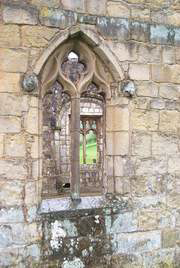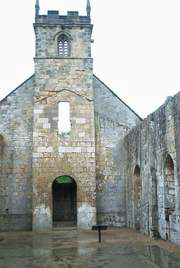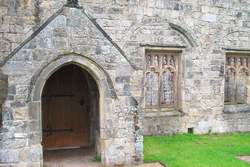The only building to have survived from the medieval period is the church, dedicated to St Martin. It continued to serve as the parish church for a parish that included three other deserted villages and the surviving village of Thixendale. However, after a church was built in Thixendale in 1870 it was used much less, and by the time the last service was held there in 1949 the church was in a severe state of disrepair. Part of the tower collapsed in 1959. Today the church is an elegant ruin.
The site of the church has been thoroughly excavated. It appears to have passed through eleven distinct phases of construction. It began as a small Saxon church in the tenth century, was substantially enlarged when it became the parish church in the twelfth century, and reached its greatest size during phase 7 in the early fourteenth century. At that time it had two side aisles, one of them leading into a small chapel. Later, as Wharram Percy declined, the side aisles were removed and the main body of the church made shorter.
A full description of the archaeology of the church, with plenty of diagrams and photographs, can be found in Chapter 3 of the book by Beresford and Hurst. Alternatively, for a summary of the stages of construction and some good conjectural drawings go to this address.
The graveyard outside the church has also been thoroughly explored. Almost seven hundred skeletons have been found in the graveyard or buried in the floor of the church. Analysis of these bones has revealed much information about the physical characteristics of people living in the village, child development and growth, disease and injuries, and methods of surgery. Some of the findings include:
- The number of infant deaths, with about 15% of infants dying before the age of one, was low in comparison to the rate found in towns during the Middle Ages. One factor that may have contributed to the low rate of infant mortality was that breast feeding was continued into the second year. Evidence for this assertion is based on the fact that a specific isotopic signal can be detected in the bones of young children fed on breast milk.
- The rate of growth during childhood was slow, with evidence that children of ten would have been about 20 centimetres shorter than children today. However, the average height of adults was not much less than today’s average, as growth appears to have continued to a much older age, in some cases as old as thirty.
- Measurements of the length of bones in the right and left arms have shown a relatively
high rate of left-
handedness. - Examination of pelvic bones has revealed damage resulting from erosion of cartilage from the joints, a state of affairs that would have caused great pain. It was probably brought about by the enormous amount of physical labour required of residents of the village.
- Indications of various diseases have been found. Tuberculosis was quite common, not the type that may be transmitted from livestock, but the form, usually more common in towns, that passes between human beings.
One skull contained a hole that would have been produced surgically in a technique known as trepanning. The man whose skull it was had been struck by a blunt object. The surgeon must have cut a hole in the skull and extracted the broken fragments of the man’s skull. The man survived.
You can read more about this piece of surgery at this address. A full discussion of the research on the human remains was presented by Aubrey Manning in a Radio 4 Programme on 14 December 2004. You can listen to the programme by going to this address.


